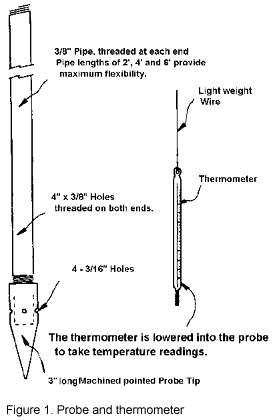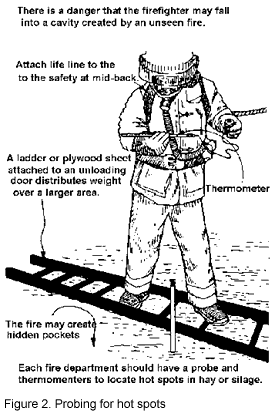This manual was prepared to inform Tennessee farmers and firefighters about the causes, prevention and control of hay fires. The information contained herein is believed to be accurate and up-to-date. However, the University of Tennessee Agricultural Extension Service will not be responsible for accidents, injuries or any other losses resulting from the application of practices described in this publication.
HAY FIRES: CAUSES,
PREVENTION AND CONTROL
Fires that damage or destroy hay and barns cost farmers thousands of dollars in terms of building replacement, feed replacement and lost revenues. This is unfortunate, because proper harvesting and storage practices can practically eliminate hay fires.
What
Causes Hay Fires?
Hay fires usually occur within six weeks of baling, but they may occur in hay several years old. Fire can occur in loose hay, small bales, large bales or in stacks. The fires can occur in hay stored inside as well as in hay stored outside. Regardless of when or where the fires occur, the most common cause is excessive moisture.
Freshly cut forage materials are not dead. Some respiration continues and a very small amount of heat is produced. This heat generated by respiration is probably of little consequence except that it may help provide proper conditions for growth of bacteria. As the moisture content of the crop decreases during the curing process, respiration will slow and eventually cease.
Forage crops are always contaminated with countless microorganisms. These microorganisms are no problem when the hay is harvested and cured to the proper moisture content before baling and storage. After baling, however, a small supply of air and a favorable moisture level cause the microorganisms to begin to feed and multiply, generating heat in the process. This heating continues up to a temperature of 130 to 140°F, at which the heat tends to kill the microorganisms.
Depending upon the exact conditions, the temperature may decrease slowly at this point as the microorganisms are killed. The hay may go through several similar heating cycles during the next weeks as the population of microorganisms increases and decreases, but the highest temperature will usually be lower each time. Eventually the temperature will stabilize near the ambient temperature.
No fire results in a case like the one described above, but there may be considerable heat damage to the hay. In some cases cows may actually prefer the taste of the brown, heat-damaged hay but the feed has decreased considerably in nutritional value.
Refer to the point where the temperature reached about 130°F. If there had been some thermophilic (heat loving) bacteria present and the heat had been retained, a second heating phase could have begun. This heating could generate enough heat to raise the temperature as high as 160 to 170°F before bacterial activity ceases.
The thermophilic bacteria and the heat they generate convert the hay to a form similar to a carbon sponge with microscopic pores. In this form and at the high temperatures present in heated hay, the material combines readily with oxygen. It can self-ignite in the presence of air and its tendency to burn is almost unbelievable.
| Table 1. Hay Recommended Moisture Contents for Baling Hay | |
| Baling Method | Hay Moisture Content1 |
| Large packages (round bale, stack) | 15-18% |
| Conventional square bale | 20-25% |
| Using innoculant based preservative2/3 | 20-25% |
| Using acid based preservative | 20-30% |
| 1
- Maximum moisture contents are for grass and legume hays. 2 - Consult label recommendations and your Extension agent before using preservatives or drying agents. 3 - As a general rule, the University of Tennessee Agricultural Extension Service does not recommend the use of innoculant based preservatives. Source: Department of Plant and Soil Science : University of Tennessee : Agricultural Extension Service |
|
Preventing
Hay Fires
Since the moisture content of hay is a key factor in microbial activity and the resultant heating, it is important that the crop be cured to the proper moisture content before baling. Maximum moisture contents recommended by the University of Tennessee Agricultural Extension Service are listed in Table 1.
Weather conditions greatly influence the rate at which the crops dry. Ideal hay curing weather has less than 50 percent relative humidity and some wind. Be aware that the moisture content of the hay will increase overnight when the air is humid, especially if there is dew or fog. Monitor weather forecasts carefully to help schedule haymaking operations.
Conditioning equipment which crimps or abrades the crop stems is helpful because it speeds the drying process. Using tedders or hay rakes to very gently fluff windrows may also speed the curing process.
Chemicals such as drying agents and preservatives, when properly used, may be advantageous with some crops, such as high quality alfalfa. Correct application is essential to avoid potential problems.
New hay which is stacked in the field or placed in a barn should be checked frequently for possible heating. At first, check in the morning and afternoon. If no signs of abnormal heating are found, the intervals may be lengthened. If the temperature reaches 130°F, move the hay to allow increased air circulation and cooling.
Hay which is to be stored uncovered outdoors (big round bales and stacks) should be formed into the tightest packages possible to resist penetration by rain. Do not place unprotected bales or stacks tightly against each other. Instead, place the bales where air can circulate freely. Protect the bales from ground moisture and runoff by placing them on a bed of gravel, old tires, poles or pallets. Plastic or other waterproof covers will protect bales by shedding precipitation.
If storing hay inside, be sure the barn roof and any plumbing do not leak. Likewise, provide adequate drainage so water will not enter the barn during storms. Hay may be at the proper moisture content when baled and stored, but wetting from a leak can allow bacterial activity to increase and result in a fire.
There are, of course, causes of hay fires other than spontaneous ignition. Some of these causes are lightning striking nearby trees or fences, arson, contact with electric fences and sparks from cigarettes, welding or nearby fires.

Measuring
To accurately determine how hot it is inside a stack of hay you should use a probe and thermometer (Figure 1). The probe is pushed or driven into the stack and the thermometer is lowered to the end of the probe on a light wire. If the probe is horizontal, use a heavier wire to push the thermometer into the probe. After 10 to 15 minutes, retrieve the thermometer and read the temperature.
| Table 2. Temperature Interpretations | |
| Below 130°F | No problem |
| 130 to 140°F | No problem yet, temperature may go up or down. Recheck in a few hours. |
| 150°F | Temperature will most likely continue to climb. Move the hay to provide air circulation and cooling. Monitor temperature often. |
| 175-190°F | Fire is imminent or may be present a short distance from the probe. Call the fire department. Continue probing and monitoring the temperature. |
| 200°F or above | Fire is present at or near the probe. Call the fire department. Inject water to cool hotspots before moving hay. Have a charged hose ready to control blazing when moving hay. |
To check the temperature without a probe and thermometer, push or drive a 3/8 to ½ inch diameter metal rod into the hay and leave it 10 to 15 minutes. Pull the rod out and test its temperature with your bare hand. If you can hold the rod in your hand comfortably the temperature is below 130°F. If you can hold it, but it is uncomfortable, the temperature is in the 130 to 160°F range. If the rod is just too hot to hold in your bare hand, the temperature is over 160°F and a fire is imminent or nearby. Table 2 gives a list of temperature interpretations.
Several probes and thermometers or several rods can be used at the same time in various locations through the stack of hay to complete the survey in a shorter period of time.
CAUTION: If you see or smell smoke coming from the hay, place boards or plywood on the hay before walking on top of it. This will spread your weight over a larger area to prevent falling into burned out cavities. A lifeline is also recommended in this case.
Controlling A Hay FireDo not move any of the hay. This would expose the overheated or smoldering hay to oxygen and may result in a fire raging out of control.
The proper procedure for controlling a hay fire is as follows:

The firefighter operating the probe should wear full turnout gear, lifeline and a SCBA. Steam may blow back along the probe or through other openings when water reaches a fire. Boards, plywood or a ladder should be used to distribute the person's weight and prevent falling into a burned-out cavity (Figure 2).
Another firefighter should assist from a safe location nearby. This person should also wear full turnout gear and should have a charged hose ready in addition to the hose needed for the probe.
When it is believed that the hot spots have been sufficiently cooled, begin removing the hay from the barn or stack. Keep a charged hose ready and manned to quickly control any blazing that may result from missed or insufficiently cooled hot spots.
Hay which has been damaged by heat, smoke or water should be removed to a safe location for disposal. Possible uses for damaged hay include mulch for erosion control on slopes and in gullies. If uncertain whether heat has damaged hay too much for feeding have a sample tested.
For additional information or assistance, contact your county Extension office. References
Publication #: PB1306
This document is apart of a series from the Agricultural Engineering Department, University of Tennessee Agricultural Extension Service, Knoxville, Tennessee 37901. Publication date: October 1988.
Timothy G. Prather, Extension Assistant, Agricultural Engineering, University of Tennessee Agricultural Extension Service, Knoxville, Tennessee 37901.
Disclaimer and Reproduction Information: Information in NASD does not represent NIOSH policy. Information included in NASD appears by permission of the author and/or copyright holder. More